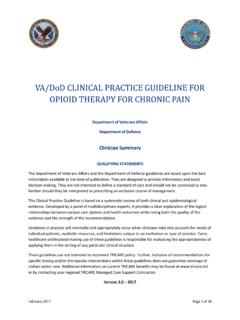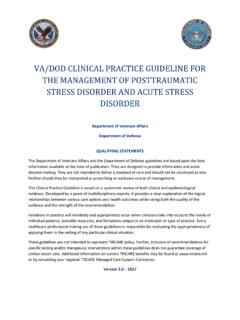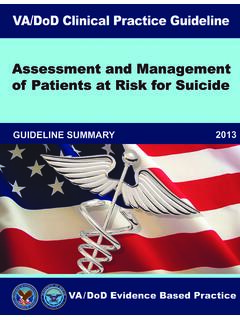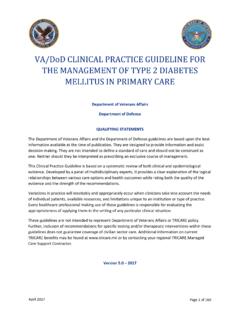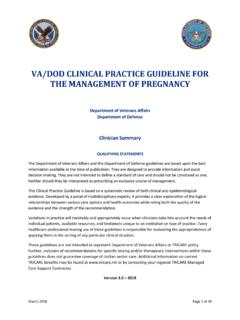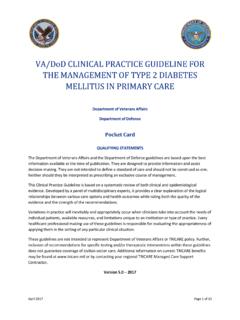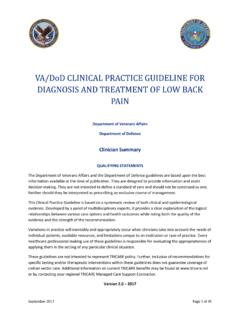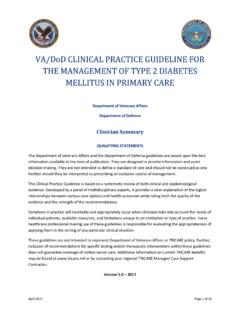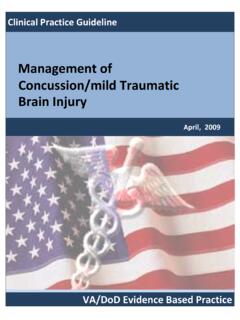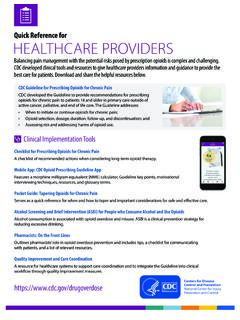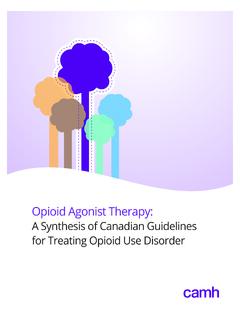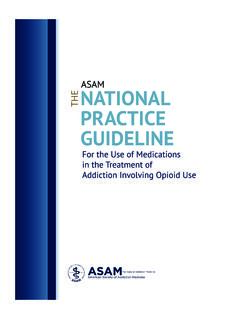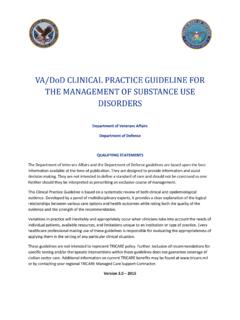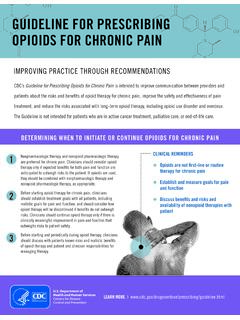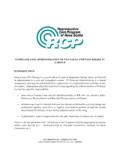Transcription of VA/DoD Clinical Practice Guideline for Diagnosis and ...
1 VA / DoD Clinical Practice Guideline FOR Diagnosis AND TREATMENT OF LOW BACK PA I N Department of Veterans Affairs Department of Defense QUALIFYING STATEMENTS The Department of Veterans Affairs and the Department of Defense guidelines are based upon the best information available at the time of publication. They are designed to provide information and assist decision making. They are not intended to define a standard of care and should not be construed as one. Neither should they be interpreted as prescribing an exclusive course of management. This Clinical Practice Guideline is based on a systematic review of both Clinical and epidemiological evidence. Developed by a panel of multidisciplinary experts, it provides a clear explanation of the logical relationships between various care options and health outcomes while rating both the quality of the evidence and the strength of the recommendation.
2 Variations in Practice will inevitably and appropriately occur when clinicians take into account the needs of individual patients, available resources, and limitations unique to an institution or type of Practice . Every healthcare professional making use of these guidelines is responsible for evaluating the appropriateness of applying them in the setting of any particular Clinical situation. These guidelines are not intended to represent Department of Veterans Affairs or TRICARE policy. Further, inclusion of recommendations for specific testing and/or therapeutic interventions within these guidelines does not guarantee coverage of civilian sector care. Additional information on current TRICARE benefits may be found at or by contacting your regional TRICARE Managed Care Support Contractor. Version 2017VA/DoD Clinical Practice Guideline for Diagnosis and Treatment of Low Back Pain September 2017 Page 2 of 110 Prepared by: The Diagnosis and Treatment of Low Back Pain Work Group With support from: The Office of Quality, Safety and Value, VA, Washington, DC & Office of Evidence Based Practice , Army Medical Command Version 2017 Based on evidence reviewed through October 21, 2016 VA/DoD Clinical Practice Guideline for Diagnosis and Treatment of Low Back Pain September 2017 Page 3 of 110 Table of Contents I.
3 Introduction .. 5 II. Recommendations .. 6 III. 9 A. Description of Low Back Pain .. 9 B. Epidemiology and Impact .. 10 a. General Population .. 10 b. Veterans Affairs Population .. 11 c. Department of Defense Population .. 11 IV. About this Clinical Practice Guideline .. 12 A. Scope of this Clinical Practice Guideline .. 12 B. Methods .. 13 a. Grading Recommendations .. 14 b. Reconciling 2007 Clinical Practice Guideline Recommendations .. 15 c. Peer Review Process .. 16 C. Summary of Patient Focus Group Methods and Findings .. 16 D. Conflict of Interest .. 17 E. Highlighted Features of this Clinical Practice Guideline .. 18 F. Patient-centered Care .. 18 G. Shared Decision Making .. 18 H. Implementation .. 19 V. Guideline Work Group .. 20 VI. Algorithm .. 21 Module A: Initial Evaluation of Low Back Pain .. 22 Module B: Management of Low Back Pain.
4 24 VII. Discussion of Recommendations .. 26 A. Diagnostic Approach .. 26 B. Education and Self-care .. 31 C. Non-pharmacologic and Non-invasive therapy .. 33 D. Pharmacologic therapy .. 39 E. Dietary Supplements .. 46 F. Non-surgical Invasive therapy .. 48 G. Team Approach to Treatment of Chronic Low Back Pain .. 50 VA/DoD Clinical Practice Guideline for Diagnosis and Treatment of Low Back Pain September 2017 Page 4 of 110 VIII. Knowledge Gaps and Recommended Research .. 51 Appendix A: Evidence Review Methodology .. 53 the Scope and Key Questions .. 53 (s) .. 53 (s) .. 54 (s) .. 56 .. 56 .. 57 .. 57 the Systematic Review .. 57 for Study 59 Search 60 the Face-to-face Meeting .. 61 Recommendations .. 62 Categorization .. 65 Recommendations with an Updated Review of the Evidence .. 65 Recommendations without an Updated Review of the Evidence.
5 66 Categories and Definitions .. 66 and Submitting the Final Clinical Practice 67 Appendix B: Dosing for Select Pharmacologic Agents1 .. 68 Appendix C: Evidence Table .. 69 Appendix D: Glossary .. 74 Appendix E: 2007 Recommendation Categorization Table .. 76 Appendix F: Participant List .. 78 Appendix G: Patient Focus Group Methods and Findings .. 80 .. 80 Focus Group Findings .. 81 Appendix H: Literature Review Search Terms and Strategy .. 83 Search Terms .. 83 Strategies .. 94 Appendix I: Abbreviation List .. 101 References .. 103 VA/DoD Clinical Practice Guideline for Diagnosis and Treatment of Low Back Pain September 2017 Page 5 of 110 I. Introduction The Department of Veterans Affairs (VA) and Department of Defense (DoD) Evidence-Based Practice Work Group (EBPWG) was established and first chartered in 2004, with a mission to advise the.
6 Health Executive Council on the use of Clinical and epidemiological evidence to improve the health of the population across the Veterans Health Administration and Military Health System, by facilitating the development of Clinical Practice guidelines (CPGs) for the VA and DoD populations.[1] This CPG is intended to provide healthcare providers with a framework by which to evaluate, treat, and manage the individual needs and preferences of patients with low back pain (LBP). In 2007, the VA and DoD published the Clinical Practice Guideline for Diagnosis and treatment of Low Back Pain (2007 LBP CPG), which was based on evidence reviewed through November 2006. Since the release of that Guideline , a growing body of research has expanded the general knowledge and understanding of LBP. Improved recognition of the complex nature of these conditions has led to the adoption of new strategies for Diagnosis and treatment of LBP.
7 Consequently, a recommendation to update the 2007 LBP CPG was initiated in 2016. The updated CPG, titled Clinical Practice Guideline for Diagnosis and Treatment of Low Back Pain (2017 LBP CPG), includes objective, evidence-b ased information on the Diagnosis and management of acute and chronic LBP. It is intended to assist healthcare providers in all aspects of patient care, including, but not limited to, Diagnosis , treatment, and management. The system-wide goal of this Guideline is to improve the patient s health and wellbeing by providing evidence-based guidance to providers who are diagnosing or treating patients with LBP. The expected outcome of successful implementation of this Guideline is to: Assess the patient s condition and determine, in collaboration with the patient, the best treatment method Optimize each individual s health outcomes and improve quality of life Minimize preventable complications and morbidity Emphasize the use of patient-centered care VA/DoD Clinical Practice Guideline for Diagnosis and Treatment of Low Back Pain September 2017 Page 6 of 110 II.
8 Recommendations # Recommendation Strength* Category A. Diagnostic Approach 1. For patients with low back pain, we recommend that clinicians conduct a history and physical examination, that should include identifying and evaluating neurologic deficits ( , radiculopathy, neurogenic claudication), red flag symptoms associated with serious underlying pathology ( , malignancy, fracture, infection), and psychosocial factors. Strong for Reviewed, Amended 2. For patients with low back pain, we suggest performing a mental health screening as part of the low back pain evaluation and taking results into consideration during selection of treatment. Weak for Reviewed, New-replaced 3. For patients with acute axial low back pain ( , localized, non-radiating), we recommend against routinely obtaining imaging studies or invasive diagnostic tests. Strong against Reviewed, Amended 4.
9 For patients with low back pain, we recommend diagnostic imaging and appropriate laboratory testing when neurologic deficits are serious or progressive or when red flag symptoms are present. Strong for Reviewed, Amended 5. For patients with low back pain greater than one month who have not improved or responded to initial treatments, there is inconclusive evidence to recommend for or against any diagnostic imaging. Not applicable Reviewed, New-added B. Education and Self-care 6. For patients with chronic low back pain, we recommend providing evidence-based information with regard to their expected course, advising patients to remain active, and providing information about self-care options. Strong for Reviewed, Amended 7. For patients with chronic low back pain, we suggest adding a structured education component, including pain neurophysiology, as part of a multicomponent self-management intervention.
10 Weak for Reviewed, New-added C. Non-pharmacologic and Non-invasive therapy 8. For patients with chronic low back pain, we recommend cognitive behavioral therapy . Strong for Reviewed, New-replaced 9. For patients with chronic low back pain, we suggest mindfulness-based stress reduction. Weak for Reviewed, New-replaced 10. For patients with acute low back pain, there is insufficient evidence to support the use of specific clinician-directed exercise. Not applicable Reviewed, New-replaced 11. For patients with chronic low back pain, we suggest offering clinician-directed exercises. Weak for Reviewed, New-replaced 12. For patients with acute or chronic low back pain, we suggest offering spinal mobilization/manipulation as part of a multimodal program. Weak for Reviewed, New-replaced 13. For patients with acute low back pain, there is insufficient evidence to support the use of acupuncture.
